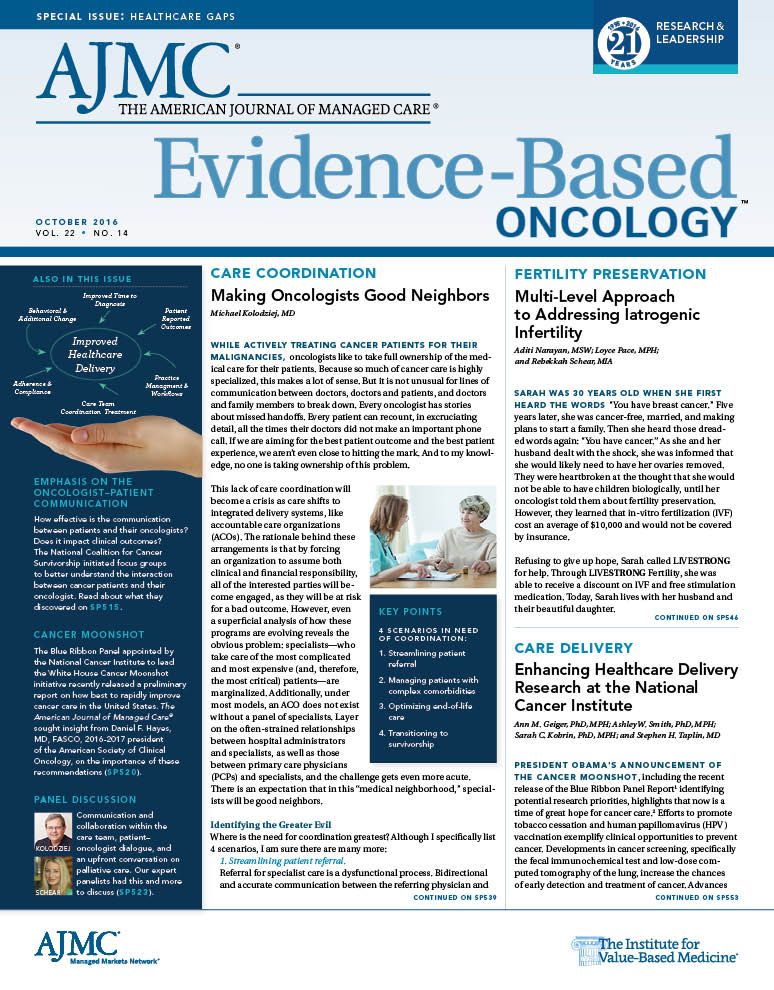- Center on Health Equity & Access
- Clinical
- Health Care Cost
- Health Care Delivery
- Insurance
- Policy
- Technology
- Value-Based Care
Minding the Gaps and Filling the Chasms in Oncology
As we enter a time of extraordinary advances in cancer care, some of the optimism over these advances has been temÂpered by the growing realization of the challenges of delivering these cancer care solutions.
In 1999, the Institute of Medicine (IOM) report, Crossing the Quality Chasm: A New Health System for the 21st Century, described an ideal healthcare system as one that delivers safe, effective, patient-centered, efficient, timely, and equitable care.1 On March 21, 2010, The Afford­able Care Act (ACA) was signed into law by President Barack Obama. The ACA was a highly ambitious piece of legislation that sought to improve the effectiveness and safety of healthcare by reducing gaps in health­care access and linking payments to improvements in healthcare quality outcomes. Important provisions of the law included a prohibition on the denial of coverage based upon preexisting conditions, the elimination of lifetime limits on insurance coverage, and the stipulation of standards for essential minimal coverage benefits (including cancer screening).2 In many ways, the ACA attempted to enshrine the IOM’s 6 aims of healthcare as important drivers of the ongo­ing evolution of American healthcare.
As we enter a time of extraordinary advances in cancer care, empowered by the rapid identification of new molecular targets and the increasing availability of targeted and immunotherapeutic agents, some of the optimism over these advances has been tem­pered by the growing realization of the challenges of delivering these cancer care solutions. Providers and healthcare systems are confronted with delivering increasingly complex cancer care more efficiently, effectively, and safely. Yet, ensuring that care is deliv­ered equitably is particularly challenging and requires an understanding of the gaps that continue to exist in cancer care delivery. These include gaps in the care of adolescent and young adult patients, patients making the transition from pediatric to adult care systems, older patients, uninsured patients, patients whose linguistic and cultural attributes may impact care, pa­tients from lower socioeconomic groups, and patients at the end of life. Gaps in care may include lack of access to specific treatments and technology, distress management, effective pain relief, and multidisci­plinary treatment planning and coordination of care.3-5
Contributor’s in this month’s issue of Evidence-Based OncologyTM review some of the key gaps in cancer care and explore how they can be more effec­tively addressed. Researchers from LIVESTRONG evaluate the importance of assessing patients care­fully for fertility preservation strategies and discuss how this should be performed as a routine part of cancer care planning. An article from the National Coalition for Cancer Survivorship emphasizes the importance of effective physician-patient communi­cation and how best to address gaps in care planning and decision-making communication. Experts from the National Cancer Institute’s Healthcare Delivery Research Program review the role of the Division of Cancer Control and Population Sciences in facili­tating behavioral, epidemiologic, and other types of research intended to decrease cancer incidence, increase cancer survival, and improve the well-be­ing of cancer patients, survivors, caregivers, and the community. Michael Kolodziej, MD, formerly with Aetna, reviews the importance of care coordination in ensuring effective longitudinal cancer care.
The rapidly expanding armamentarium of high-tech cancer care therapeutics and the growing focus on precision medicine solutions have deeply altered our perceptions of effective cancer care; however, the most important aspect of caring for patients affected by cancer begins with a personal focus on the patient before us. Although the quest for more effective technical solutions provides the basis for soaring rhetoric, the real-world healthcare needs, knowledge and access gaps to effective care, and the prosaic work of care coordination and goals of care planning represent some of the areas of greatest opportunity facing patients today.Joseph Alvarnas, MD, is director, Medical Quality and Quality, Risk, and Regulatory Management, City of Hope, Duarte, CA.References
1. Across the chasm: six aims for changing the health care system. Institute for Healthcare Improvement website. http://www.ihi.org/resources/pages/ improvementstories/acrossthechasmsixaimsforchangingthehealthcaresys­tem.aspx. Accessed October 3, 2016.
2. Key features of the Affordable Care Act by year. HHS website. http:// www.hhs.gov/healthcare/facts-and-features/key-features-of-aca-by-year/index.html#. Accessed October 3, 2016.
3. Park A. The cancer gap. Time website. http://time.com/3750523/the-can­cer-gap/. Published March 19, 2015. Accessed October 3, 2016.
4. Thigpen E. Closing the gaps in cancer care for young adults. LIVES­TRONG website. http://blog.livestrong.org/2014/04/07/closing-the-gaps-in-cancer-care-for-young-adults/. Published April 7, 2014. Accessed October 3, 2016.
5. Shaffer AT. Survey finds gaps in cancer care communications. OncLiveTM website. http://www.onclive.com/web-exclusives/survey-finds-wide-gaps-in-cancer-care-communications. Published June 18, 2014. Accessed October 4, 2016.


